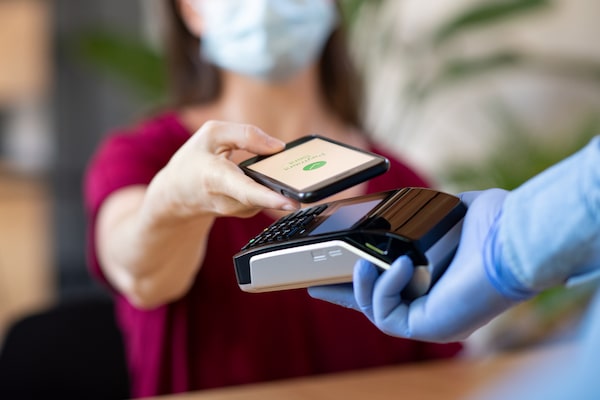
A PayPal consumer study earlier this year found Canadians have increased monthly online spend by over $3-billon a month since the pandemic started, with nearly all of it being cashless payments.francescoridolfi.com/iStockPhoto / Getty Images
The pandemic has accelerated a cashless revolution in Canada that’s destined to gather speed, predicted a panel of experts during a recent Globe and Mail virtual event, Cashless Future: Business Strategies for the Digital Economy.
A 2019 Globe and Mail/Angus Reid poll found 70 per cent of young Canadians between the ages of 26 and 37 were already cash-averse, and 57 per cent of Canadians over the age of 55 said they rarely carry cash, said moderator Sean Silcoff, The Globe and Mail’s technology reporter.
A PayPal consumer study earlier this year found Canadians have increased monthly online spending by over $3-billon a month since the pandemic started, with nearly all of it being cashless payments, added Mike Monty, director of enterprise sales for PayPal.
“The shift has happened because of the pandemic and people being locked down. One in four in the survey said they don’t expect to use cash at all within the next five years and three in five said they expect that their shopping transactions will all be digital,” Mr. Monty said. “The comfort around using cash has become an issue, as people don’t really want to handle something that multiple other people have touched. And that has accelerated the trend toward businesses bringing touch-free payment systems into their environments.”
People don’t really want to handle something that multiple other people have touched.
— Mike Monty, director of enterprise sales, PayPal
A cashless transition was easier than anticipated for Seneca College, which two years ago went digital for everything from tuition to parking and vending machines at its seven campuses that serve a total of 35,000 full-time students and 4,000 employees, said Radha Krishnan, vice-president of information services for the college. The transition was remarkably smooth, and even international students who don’t have a Canadian bank account can load a campus-wide One Card with wire transfers from a foreign bank or international money transfer.
“Setting up a digital payment system was a lot simpler than I would have thought, and I wasn’t savvy about the digital world,” said Jenn Harper, founder and chief executive officer of Cheekbone Beauty Cosmetics Inc., an Indigenous-owned consumer cosmetics company that began as a basement operation in 2016 and now has a digital platform and products in nine stores in Canada.
“I realized that implementing payment through services like PayPal on the website made the customers feel safe and secure,” she said. “And it ended up being the only way for us to connect to customers during the pandemic.”
“Having a cashless payment infrastructure was a notable selling point for us during the pandemic,” added Jessica Lynch, vice-president of strategy and development at stackt, a Toronto market constructed of shipping containers.
While the retailers at stackt prefer payment by major credit cards, debit cards and paperless transfers, “I would never alienate a customer by saying no, we will not accept cash,” she said. But only a fraction of a per cent of their 1.5 million customers a year have insisted on cash payment, she noted.
The cost of setting up a cashless store is lower than in the past, when proprietary hardware and software interfaces were required, Mr. Monty said. And for the vendors, there is a security benefit for front-line employees not having to handle cash transactions, plus protection against fraud.
“We have over four million consumer and merchant accounts globally,” he said. “That gives us access to a huge pool of data we are continually using to keep up with the latest trends in fraud and cybersecurity issues.”
Making a cash-free society inclusive is still an issue, the panelists agreed.
“Understanding how this affects people who might not be able to open up a bank account, might not be able to purchase a cell phone and who are just not born into this technically savvy world is critical,” Ms. Lynch said. “We need to address the full 360, so we provide solutions to them.”
It’s only going to be a matter of time before the Bank of Canada digitizes currency, Mr. Krishnan predicted. “Even for paying tips in a taxi, you’ll be scanning a QR code and paying from your digital wallet.”
“My big takeaway is that small-business owners who may be fearing a cashless future should ignore the fear-mongering and negativity,” Ms. Lynch concluded. “When you step into the digital future, it is not scary or complicated.”
This article originally named Radha Krishnan’s title and the number of full time students at Seneca College incorrectly, and has since been updated to correct this.